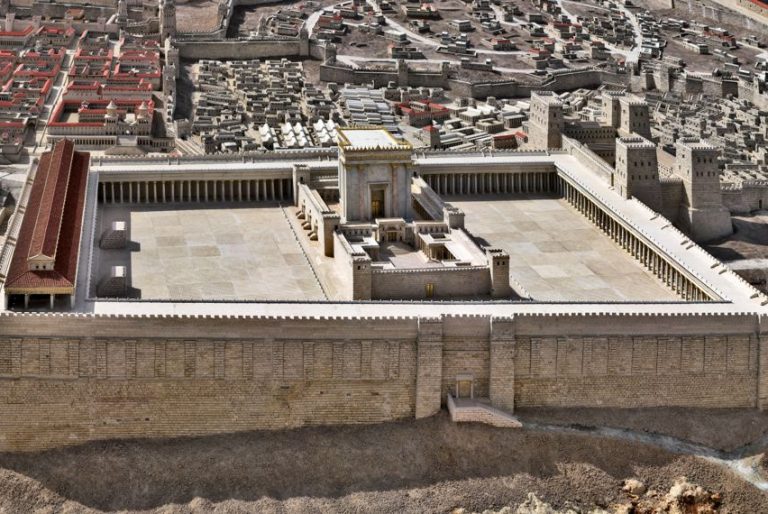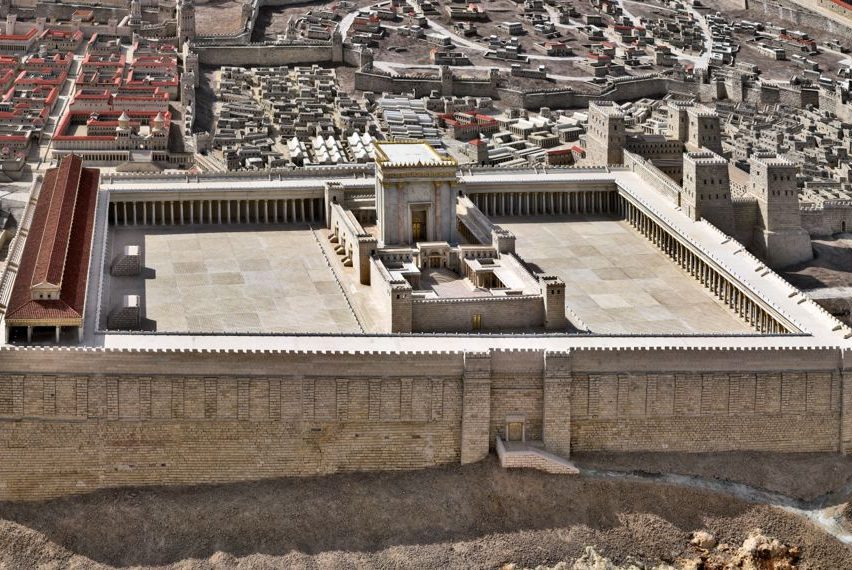The Kohen Gadol is forbidden to enter the Kodesh HaKodashim (Holy of Holies) in his regular, golden-thread priestly vestments [“Bigdei Zahav”]. Rather, special white garments [“Bigdei Lavan”] are required for Yom Kippur Avodah in the Kodesh HaKodashim. Chazal explain that this rule is predicated upon the negative inferences of the golden-thread vestments, for they invoke the memory of the Chet Ha-Egel [Sin of the Golden Calf], which is surely not appropriate to bring up as the Kohen Gadol seeks forgiveness.
 It may be asked why Bigdei Zahav were banned only from the Kodesh HaKodashim. Certainly, the entirety of the Yom Kippur Service is geared toward forgiveness. Should not Bigdei Lavan be the exclusive, required dress at all times on that most holy day?
It may be asked why Bigdei Zahav were banned only from the Kodesh HaKodashim. Certainly, the entirety of the Yom Kippur Service is geared toward forgiveness. Should not Bigdei Lavan be the exclusive, required dress at all times on that most holy day?
The answer may be based on the unique quality of the Kohen Gadol’s activity in the Kodesh HaKodashim. The Kodesh HaKodashim housed the Aron (Ark) which contained the Luchos (Tablets). Only the Kohen Gadol was licensed to enter the Kodesh HaKodashim, and his entry was limited to Yom Kippur. If we think about it, we can deduce that the Kohen Gadol’s entry to the Kodesh HaKodashim was a manifestation of Moshe’s encounter with Hashem following the Chet Ha-Egel. Moshe Rabbeinu ascended the mount by himself, unaccompanied by anyone else. As part of the rapprochement, Hashem allowed Moshe to experience the Shechina (Divine Presence) in a manner unparalleled by any other human. Moshe’s ascent culminated with the creation of new Luchos and the granting of divine forgiveness; this happened on Yom Kippur. Similarly, on Yom Kippur, the Kohen Gadol communes with God in a setting of ultimate holiness and privacy, the meeting is at the site of the Luchos, and it serves to grant expiation for sin. The Kohen Gadol thereby replicates Moshe’s encounter with God at Sinai on Yom Kippur. The entirety of Moshe Rabbeinu’s ascent was precipitated by the Chet Ha-Egel and served to negate its effects; thus, the replication of this ascent, as enacted by the Kohen Gadol on Yom Kippur, dare not invoke the memory of the Chet Ha-Egel. This is why Bigdei Lavan are a unique requirement for service in the Kodesh HaKodashim on Yom Kippur.
——————————————————————————–
The role of the Kohen Gadol (High Priest) in the Yom Kippur Avodah (Temple Service) is quite intriguing. Halacha mandates that the Kohen Gadol sacrifice a bull as a Korban Chatas (Sin Offering) and confess (1) the sins of himself and his household, and (2) the sins of the Kohanim, prior to slaughter. This bull must also be the personal property of the Kohen Gadol; it is not purchased with public funds. The Kohen Gadol then offers a goat as a Chatas on behalf of the entire nation. After sacrifice, both animals are intertwined and burned together.
Why is the bull reserved for Vidui for the Kohen Gadol, his family and his fellow Kohanim, and is not utilized for confession on behalf of the entire Jewish People? Why must the bull be the Kohen Gadol’s personal property?
The answer is that teshuva (repentance) and kappara (forgiveness) function on two levels: that of the individual and that of the general community, in which Jews as one public body supplicate to Hashem and are communally forgiven. The Kohen Gadol’s personal sacrifice and confession [“Vidui”] represent the teshuva and kappara process of the individual; sacrifice of the goat symbolizes the teshuva of the tzibbur (community). We are bound to engage in both levels of teshuva on Yom Kippur. Furthermore, God bides us to repent and take responsibility for our own misdeeds, and He also mandates that we link up with the tzibbur and repent through public Avodah, which is given unique attention. The intertwining of the bull and goat reflect the interrelationship of teshuva of the individual and the public, such that we must entreat God as both private citizens and members of the Jewish community as a whole. This two-tiered teshuvah system is the basis for Avodah and forgiveness on Yom Kippur.
——————————————————————————–
The first mishna in Yoma stipulates that the Kohen Gadol must be sequestered for one compete week prior to Yom Kippur to purify himself and prepare for the holiday. The Gemara compares this sequestering to the full week of sequestering and purification of the Kohen who burned the Parah Adumah [“Red Heifer”] before performing that mitzvah. The basis for comparison is that instruments of public purification must themselves be pristine and untainted in order to represent the tzibbur and effect taharah (purification) for it. The Parah Adumah and Kohen Gadol on Yom Kippur are Klal Yisroel’s (the Jewish People’s) emissaries for attaining spiritual purification. If these emissaries are unfit or even slightly lacking in their own spiritual readiness, they do not merit to function as conduits for God’s endowment of taharah upon His nation. So, too, must we be ever aware that in order to perform any roles as public functionaries [whether we perform as rabbis, chazzanim, teachers, leaders or otherwise], it is first necessary to purify ourselves so that we can most effectively be conduits of kedusha (holiness) between Hashem and His nation.
——————————————————————————–
The Yom Kippur Avodah features two goats. The first was a Korban Chatas, as noted above, and the second was sent off a cliff in the barren desert. This second goat had a scarlet ribbon attached to its horns, and a separate fragment of that ribbon was likewise tied to the top of the cliff where the goat was led. When the goat reached its final destination, the ribbon on the cliff turned white, indicating the Hashem forgave His people. What do this second goat and the ribbon symbolize?
Chazal (our sages) have noted that forgiveness is a divine gift. The ability for sins to vanish is illogical and impossible in human terms; only God can effect such a miracle. This is the message of the goat. The goat is discarded, never to be seen again, in a location which assures its irrevocable removal and destruction. The ribbon spontaneously turns white; neither the person who leads the goat nor anyone else is involved with the color change; it is clearly a divine effect. So, too, sins once ominous vanish, and God purifies us in defiance of human logic and capability. This is the miracle of Yom Kippur.

